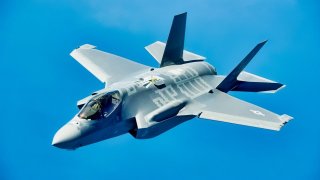F-35 Fighter Could Soon Fire Mach 5 Hypersonic 'Mako' Missiles
The Mako Multi-Mission Hypersonic Missile, named after the fastest shark in the sea, was showcased at the Sea Air Space 2024 conference. Developed by Lockheed Martin and CoAspire, initially for the U.S. Air Force's Stand In Attack Weapon (SiAW) program, it is now being pitched to the U.S. Navy.
Summary: The Mako Multi-Mission Hypersonic Missile, named after the fastest shark in the sea, was showcased at the Sea Air Space 2024 conference. Developed by Lockheed Martin and CoAspire, initially for the U.S. Air Force's Stand In Attack Weapon (SiAW) program, it is now being pitched to the U.S. Navy. The Mako, capable of reaching speeds of Mach 5, has been tested on the F-35 Lightning II and can be fitted on various U.S. military aircraft. Its versatility and speed position it as a significant advancement in hypersonic weaponry, potentially enhancing the U.S. Navy's capabilities significantly.
Mako Multi-Mission Hypersonic Missile for F-35?
The shortfin mako is the fastest shark in the sea and is thus a fitting name for the newly unveiled Mako Multi-Mission Hypersonic Missile that was unveiled at the Sea Air Space 2024 conference this week. Lockheed Martin, in partnership with CoAspire initially developed the new ordnance platform with internal funding for the U.S. Air Force Stand In Attack Weapon (SiAW) program, but it is now being pitched to the U.S. Navy for use on carrier-based aircraft.
The new missile, which has been in development for seven years, is capable of reaching five times the speed of sound, and it has already been tested on the Lockheed Martin F-35 Lightning II fifth-generation stealth fighter.
"For the U.S. Navy, this is a multi-mission, highly capable, survivable and affordable system, so you will keep many targets at risk with a weapons system that is ready now," Rick Loy, senior program manager in Lockheed Martin's missile division, told Naval News at the conference.
Though Lockheed Martin has touted the Mako for its speed, affordability, and targeting versatility; it was not aimed at the U.S. Navy's Hypersonic Air Launched Offensive (HALO) Anti-Surface program, which called for the development of anti-ship capability to the sea service's F/A-18 Super Hornets.
The Mako Missile – What We Know
Key details are still sparse about the Mako, but it has been disclosed that it would reach at least Mach 5, while it could be employed on any aircraft that has 30-inch lugs, including those with the BRU-32 heavy-duty ejector rack according to the report from Naval News.
The Mako can be deployed from carrier-based and land-based aircraft including the F-15EX Eagle II, F-16 Fighting Falcon, F/A-18 Super Hornet, F-22 Raptor, and F-35 Lightning II – but also the U.S. Navy's P-8 maritime patrol and reconnaissance aircraft.
"The world is interested in hypersonic capability and we are interested in providing it to them," Loy added.
The Mako and the F-35
Perhaps the most notable aspect of the Mako is that it could be employed with the F-35, carrying four of the hypersonic missiles externally and two internally – with one in each weapons bay.
As reported by Stefano D'Urso for TheAviationist, this could make the Mako the first hypersonic weapon truly compatible with the fifth-generation multirole fighter. None of the other hypersonic weapons – at least those we know of – are being developed to fit inside the F-35's weapons bay, and even Lockheed Martin's Hypersonic Air-breathing Weapon Concept could only be carried externally.
"Should Mako be procured, an internally carried hypersonic weapon would greatly expand the capabilities of the F-35," wrote D'Urso.
While the Mako is still under development and has no contract from the U.S. military, it could be a potential game changer – and prove that perhaps the U.S. isn't so far behind in the race to field a viable air-launched hypersonic weapon.
Author Experience and Expertise: Peter Suciu
Peter Suciu is a Michigan-based writer. He has contributed to more than four dozen magazines, newspapers, and websites with over 3,200 published pieces over a twenty-year career in journalism. He regularly writes about military hardware, firearms history, cybersecurity, politics, and international affairs. Peter is also a Contributing Writer for Forbes and Clearance Jobs. You can follow him on Twitter: @PeterSuciu.
You can email the author: [email protected].


